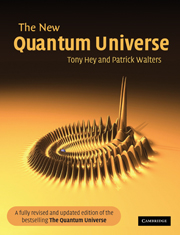Book contents
- Frontmatter
- Contents
- Preface
- Prologue
- Route map
- 1 Waves versus particles
- 2 Heisenberg and uncertainty
- 3 Schrödinger and matter waves
- 4 Atoms and nuclei
- 5 Quantum tunnelling
- 6 Pauli and the elements
- 7 Quantum co-operation and superfluids
- 8 Quantum jumps
- 9 Quantum engineering
- 10 Death of a star
- 11 Feynman rules
- 12 Weak photons and strong glue
- 13 Afterword – quantum physics and science fiction
- Epilogue
- Appendix 1 The size of things
- Appendix 2 Solving the Schrödinger equation
- Glossary
- Quotations and sources
- Suggestions for further reading
- Photo-credits
- Name index
- Subject index
5 - Quantum tunnelling
Published online by Cambridge University Press: 05 October 2013
- Frontmatter
- Contents
- Preface
- Prologue
- Route map
- 1 Waves versus particles
- 2 Heisenberg and uncertainty
- 3 Schrödinger and matter waves
- 4 Atoms and nuclei
- 5 Quantum tunnelling
- 6 Pauli and the elements
- 7 Quantum co-operation and superfluids
- 8 Quantum jumps
- 9 Quantum engineering
- 10 Death of a star
- 11 Feynman rules
- 12 Weak photons and strong glue
- 13 Afterword – quantum physics and science fiction
- Epilogue
- Appendix 1 The size of things
- Appendix 2 Solving the Schrödinger equation
- Glossary
- Quotations and sources
- Suggestions for further reading
- Photo-credits
- Name index
- Subject index
Summary
It is possible in quantum mechanics to sneak quickly across a region which is illegal energetically.
Richard FeynmanBarrier penetration
One of the most startling consequences of de Broglie's wave hypothesis and Schrödinger's equation was the discovery that quantum objects can ‘tunnel’ through potential energy barriers that classical particles are forbidden to penetrate. To gain some idea of what we mean by an energy barrier, let us go back to our roller coaster and look at a larger section of track, as shown in Fig. 5.1. If we start the carriage from rest, high up on the left, at A, and ignore any small frictional energy losses, we know from the conservation of energy that we shall arrive on the other side at the same height we started from, at C. As we went over the little hill B, at the bottom of the valley, the car slowed down as some of our kinetic energy was changed to potential energy in climbing the hill, but because we started much higher up, we had plenty of energy to spare to get us over the top. However, if we started the carriage from rest at A, we do not have enough energy to climb over the hill D and get to E. This is an example of an ‘energy barrier’, and we can say that the region from C to E is ‘classically forbidden’.
What is remarkable about quantum ‘particles’ is that they do not behave like these classical objects.
- Type
- Chapter
- Information
- The New Quantum Universe , pp. 73 - 106Publisher: Cambridge University PressPrint publication year: 2003

